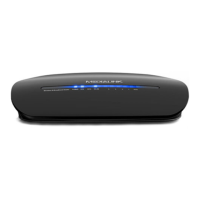
Do you have a question about the Medialink MWN-WAPR150N and is the answer not in the manual?
| Brand | Medialink |
|---|---|
| Model | MWN-WAPR150N |
| Category | Wireless Router |
| Language | English |
Detailed list of the router's capabilities and specifications, including speed and standards.
Lists all items included in the router's packaging for user verification.
Explains the function of front panel LEDs and rear panel ports for device status.
Step-by-step guide for installing the router for non-DSL modem users, covering hardware setup.
Troubleshooting steps for users who cannot access their modem during router setup.
Step-by-step guide for installing the router specifically for DSL modem users.
Instructions on configuring a DSL modem into bridged mode for router compatibility.
Guidance on setting up two routers to work together, either wired or wirelessly.
Instructions on how to connect various wireless devices to the newly set up router.
Tips and advice on positioning the router for the best possible wireless signal coverage.
Detailed steps to access the router's web-based graphical user interface (GUI) for configuration.
Guide on configuring network settings on a computer to ensure proper communication with the router.
Walks users through the router's setup wizard for a fast and easy initial configuration process.
Configuration options for the router's Local Area Network (LAN) TCP/IP parameters.
Settings related to the Wide Area Network (WAN) connection, such as PPPoE, Static IP, etc.
Allows cloning the MAC address of a network device for ISP compatibility.
Configuration for Domain Name System (DNS) servers to resolve domain names to IP addresses.
Core settings for the wireless network, including SSID, network mode, and channel.
Configuration of encryption methods (WEP, WPA, WPA2) and passwords for securing the wireless network.
Advanced wireless configuration options for optimizing performance and features.
Setup for Wi-Fi Protected Setup (WPS) to easily connect devices without manual password entry.
Configuration for Wireless Distribution System (WDS) to extend wireless network coverage.
Allows blocking or allowing specific wireless clients based on their MAC addresses.
Displays the connection status and information of wireless clients connected to the router.
Configuration of the router's DHCP server to automatically assign IP addresses to network devices.
Manually manage IP address assignments to specific devices using MAC addresses.
Allows specific services or applications to be accessed from the internet via assigned IP addresses.
Exposes a specific computer on the LAN to the internet for special applications like gaming.
Configuration for Universal Plug and Play (UPnP) to automatically manage port forwarding for applications.
Manages and limits internet bandwidth for specific devices or IP address ranges.
Limits internet access for specific computers based on IP address and time.
Controls access to specific websites by filtering URLs based on keywords or patterns.
Restricts internet access for specific devices based on their MAC addresses and time schedules.
Enables the router's built-in firewall to protect the network from various online threats.
Allows network administrators to manage the router remotely from outside the local network.
Checks the status of the internet connection by performing a ping test from the WAN side.
Displays the router's routing table, showing paths for data transfer to destinations.
Configures the router's time zone and system time for accurate logging and scheduling.
Sets up Dynamic Domain Name System (DDNS) to map a domain name to a dynamic IP address.
Allows backing up and restoring the router's configuration settings.
Resets all router settings back to their original factory default values.
Provides instructions for upgrading the router's firmware to the latest version.
Restarts the router to apply settings or resolve issues.
Allows changing the router's login username and password for enhanced security.
Views the router's system log for troubleshooting and monitoring network events.
Exits the router's web-based configuration interface.